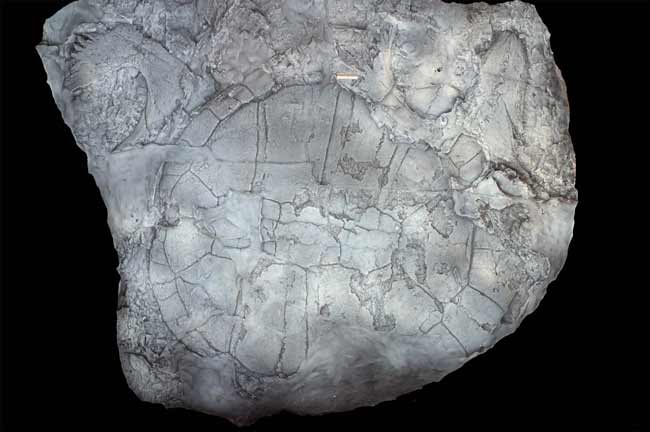Tropical Turtle Fossil Found in Arctic

The last place scientists expected to find the fossil of a freshwater, tropical turtle was in the Arctic. But they did.
The discovery, detailed today in the journal Geology, suggests animals migrated from Asia to North America not around Alaska, as once thought, but directly across a freshwater sea floating atop the warm, salty Arctic Ocean. It also provides additional evidence that a rapid influx of carbon dioxide some 90 million years ago was the likely cause of a super-greenhouse effect that created extraordinary heat in the polar region.
"We've known there's been an interchange of animals between Asia and North America in the late Cretaceous period, but this is the first example we have of a fossil in the High Arctic region showing how this migration may have taken place," said John Tarduno, professor of geophysics at the University of Rochester. "We're talking about extremely warm, ice-free conditions in the Arctic region, allowing migrations across the pole."
Turtles may be slow, but they're known to migrate long distances. Recent satellite tracking found a leatherback turtle traveled 12,774 miles (20,558 kilometers) from Indonesia to Oregon, one of the longest recorded migrations of any vertebrate animal.
Tarduno led an expedition into the Canadian Arctic in 2006 to study an ancient aspects of Earth's magnetic field. Knowing the barren location was rich in fossils, they kept an eye out.
The team found the fossil of a tropical, freshwater, Asian turtle. Tarduno's knowledge of Earth's crust allowed him to determine the fossil did not get moved there by shifts in the crust known as tectonic activity. The turtle died and remained where it was found. It has been named the aurora turtle.
That raised a question: How could a freshwater turtle navigate a salty ocean, which existed at the region back then?
Sign up for the Live Science daily newsletter now
Get the world’s most fascinating discoveries delivered straight to your inbox.
Tarduno and colleagues think the Arctic Ocean was more separated from the rest of the world's oceans at that time, reducing circulation. Numerous rivers from the adjacent continents would have poured freshwater into the sea. Since freshwater is lighter than saltwater, Tarduno thinks it may have rested on top, allowing a freshwater animal such as the aurora turtle to migrate with relative ease.
Similar changes may be occuring in parts of the oceans today. A study in 2005 found that since the late 1960s, much of the North Atlantic Ocean has become less salty, in part due to increases in freshwater runoff induced by global warming, scientists say.
The fossil was found atop basalt, a rock associated with lava flows. That offers a clue as to what might have warmed the climate 90 million years ago.
"We found this turtle right on top of the last flood basalts — a large stretch of lava from a series of giant volcanic eruptions," says Tarduno. "That leads us to believe that the warming may have been caused by volcanoes pumping tremendous amounts of carbon dioxide into the Earth's atmosphere. There's evidence that this volcanic activity happened all around the planet — not just the Arctic. If it all happened on a short enough timescale, it could cause a super-greenhouse effect."
- 10 Most Incredible Animal Journeys
- Why Did Humans Migrate to the Americas?
- Do All Turtles Have Shells?










